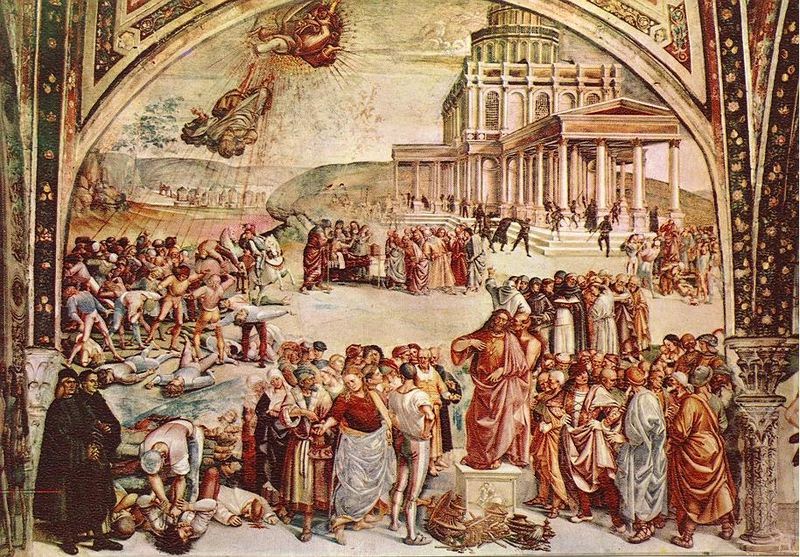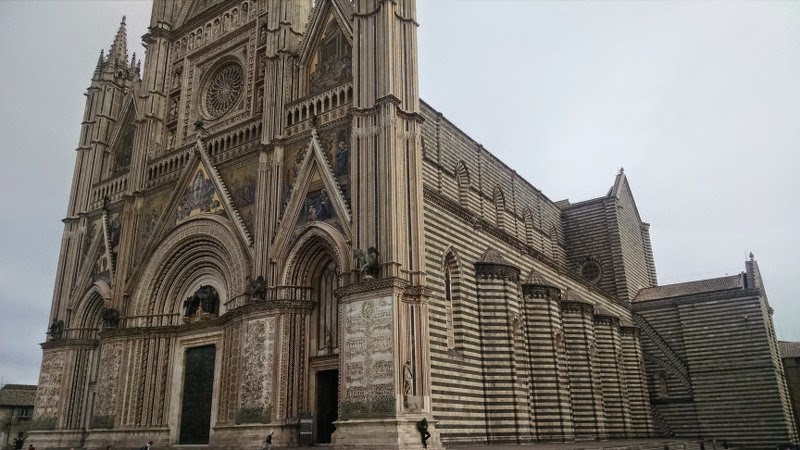 |
I Pellegrini
(Photo provided by Rick Johnson, taken by Alexis Darbonne)
(Larger at bottom with key) |
[Well, from the lateness of this post you can see that my
ambition of “live-blogging” this trip with daily updates ended up being a
bust. As I’ve mentioned already, one of
the trade-offs of being part of a packaged trip like this and thus not having to
worry about arrangements and so forth, just be where they said when they said –
and this trip went off virtually flawlessly in that respect – is being on
someone else’s schedule, and they drove us pretty hard. It had to be that way, I understand, to get
in all the things we wanted to do. But by
the end of each day mental as well as bodily weariness made it virtually
impossible to think coherent thoughts much less compose an extended
narrative. A substantial three-course dinner, with wine, did not help the cause of blogging. I did good to get notes
jotted down in my pocket journal. So I’m
actually “back-writing” this – on the plane, just out of Rome, on the morning
of Wednesday 29 October, just out of Italian air-space over the south of
France! Nevertheless, I’m going to write
each day’s entry as if I were more timely … as I wanted to be!]
This morning was what Debra called “Six-Seven-Eight” – wake-up
at 06:00, breakfast at 07:00, assembled in the lobby at 08:00 to head down to
the bus park for our drive to Orvieto [LINK],
located about an hour and a half away from Assisi. I tried to get some work done on the bus, but
very quickly found that typing was next to impossible. So I just put the laptop away and enjoyed the
scenery since I also found it impossible to nap. As we drove, the terrain became even more
mountainous than around Assisi. My
inexperienced mental image of Italy, with the Appenines down the eastern spine
of the peninsula and “broad, rolling plains” in the west, was not all that
accurate, I found!
 |
| Orvieto |
Orvieto is located in southwestern Umbria and makes a
magnificent sight as you approach – the town center is located atop the flat
(more or less) summit of a volcanic butte.
Although there is now access via a steep road for cars, busses cannot
drive up there, so we had to disembark and transfer to a funicular, an inclined cable car to go up there. The name of the city comes from the Latin Urbs vetus, “The Old City,” and old it
is, being the location of one of the major Etruscan cities with a wealth of
Etruscan ruins. The Etruscans were a
mysterious pre-Roman people in western Italy.
Unfortunately, although it was one of my ambitions, our limited time
here did not allow me to go through the Etruscan museum. There was plenty else to see and do. Anyway, the city was annexed by Rome in the third
century BC … and became something of a backwater. We just don’t know that much about Roman
Orvieto. Our guide for the city
attributed that to the fact that since the Romans dominated all of Italy by
that time (more or less) they didn’t put so much premium on the easy
defensibility of the plateau and stayed down below, but as the Empire became
the early Middle Ages such defensibility became much more important and the
height flourished once more. Medieval
Orvieto was an early episcopally-ruled city, with close relations to the
Papacy, eventually becoming part of the Papal States until 1861 when all of
Italy but Rome itself was united into a kingdom. The importance of Orvieto to the Papacy, as
well as the fact that it was where St. Thomas Aquinas was teaching before he
became Papal theologian to Clement IV, are both important in the story
explaining Orvieto’s importance as a destination for pilgrims.
 |
| The Duomo in Orvieto |
After a short bus trip from the upper end of the funicular to the cathedral square of
Orvieto, our breath was taken away by the sudden sight of the Duomo. “Duomo” is the generic Italian word for
“cathedral,” it turns out, totally unrelated to the dome that usually surmounts
it. The word derives instead from the
Italian word for house. The Duomo of
Orvieto [LINK] presents
a magnificent façade, covered with bas-reliefs of Biblical scenes, mosaics, and
carved statues of the four evangelists.
 |
| The Chapel in the Crypt |
After only a few minutes gazing in awe, however, it was time for us to
walk around to the back of the cathedral … walking on a sidewalk of old
gravestones … for an 11:00 Mass in a chapel in the crypt accessible from
outside. There were bones visible
through a window in the front of the altar, as well as several windows inset
into the floor through which we could look down into the catacombs carved in
the tufa below the Duomo – much like the Etruscans’ underground necropolis,
“City of the Dead.” I don’t know whose
were those bones in the altar, but Fr. Chris said Mass over those relics, with
Fr. Ryan assisting. By the way, it was
quite cool today, including down in that crypt.
After Mass, about 11:45 we scattered for lunch. Anne and I ended up at a little restaurant
called L’Altro Vissani, sharing margarita pizza and prosciutto. We
experienced the peculiarly saltless bread of the region around Orvieto. There is a story behind it, but I don’t
remember it.
 |
| The Chapel of the Corporal [SOURCE] |
We reassembled in the Piazza del Duomo at
13:30, meeting our guide, Manuela. She
took us through the Duomo, where the highlight was that aforementioned reason
Orvieto is a pilgrimage center: The Corporal
of Bolsena … a material relic of
the Eucharistic Miracle of 1263. In that
year, a priest in Bolsena, a town about twelve miles to the southwest of Orvieto, who was skeptical of the Real Presence of Our Lord in the
Eucharist,received an astounding confirmation of that truth when the Host that
he doubtfully consecrated began to bleed onto the corporal, the cloth placed
between the chalice and the Host during Mass.
The priest’s disbelief was not alone during that period of intense
controversy regarding the doctrine of Transubstantiation which would soon be
formally expressed by St. Thomas Aquinas in the Summa Theologiae. Pope Urban
IV investigated the claimed miracle, consulted with St. Thomas who was
currently teaching at Orvieto, and commissioned him to compose the liturgy for
the new Feast of Corpus Christi, established in the next year 1264. And, of course, translated the corporal
bearing the blood of Jesus from Bolsena to the Papal city of Orvieto, where it
would eventually be enshrined in the northern transept of the Duomo whose
building was begun in 1290 and would be dedicated to the Assumption of the
Blessed Virgin Mary.
 |
| The Orvieto Apocalypse [SOURCE] |
After only a few minutes venerating the Corporal, Manuela
continued our tour. In the southern
transept we saw another awe-inspiring sight, the great frescoes depicting the
Apocalypse as envisioned by Luca Signorelli in the late 15th
century [LINK]. The famous image of the
Antichrist – painted to look at first glance like Jesus Himself with Satan
whispering in His ear – occasioned a short impromptu teaching moment by the
Fathers about the seductive attraction of sin. [As a side note: Talk about timing! Just last week I started reading a book urged on me by both Fr. Ryan and Hugh Santos, Michael P. O'Brien's Father Elijah: An Apocalypse. In addition to the settings so far, just a third or so of the way into the book, including Rome and Assisi, these frescoes in Orvieto form a major aside in the narrative.]
 |
| The Piazza in front of the Duomo |
Out of the Duomo, Manuela walked us through a couple of
sections of the town, and then we were free once more for a little less than an
hour, which afforded us a chance for gelato
and shopping as we made our ways back to the Plaza of the Duomo for 16:00. I took time to revisit and pray before the
relic as well as catch a quick look at the Umbrian countryside off the cliff
just south of the Duomo.
 |
| The view from Orvieto across the countryside |
Here I will insert an observation regarding something that
would be with us from that day on, basically everywhere except Assisi –
beggars. Some were simply that, begging,
and either horribly deformed or faking it very well. Many were obviously the latter – there in
Orvieto we saw the first of many whose feet seemed stunted or twisted all in
basically the same manner. It was an
extremely common affliction – and one could not help throwing them a couple of
coins at least, especially when it seemed genuine. But very quickly it became apparent that many (most? all?) were faking, and our hearts – or at least mine – became hardened. We are to see Jesus in the poor, but are we to see Him in the con artist? And then there were the people trying to push cheap merchandise off on
us. “No, grazie,” especially when followed by “seniore” or “seniora,”
only encouraged them more – I started barking a firm “NO!” when first approached, which worked … most of the time. It was quite annoying.
In any case, a quick bus ride and the funicular down to the bus park, and the bus headed back to Assisi,
arriving about 18:00, after we had watched maybe the first half of an EWTN
movie about Sts. Francis and Clare. It
seemed very good, but I was kind of in and out of it with little cat-naps. Back in Assisi, Anne and I hit a gift shop,
and made it back to the hotel with just enough time to freshen up in our room
and get back down for dinner at 19:00.
As usual, it was three courses, pork steaks for the middle course. After dinner, I stayed down in the lounge for
better wifi reception and checking in on my courses. I tried to get some work done on this blog,
but what I said before – plus being distracted by other pilgrims’ talking about
the trip thus far kept that from happening.
I also had to get back to the room to be able to have our suitcases
ready to be picked up outside our rooms by 06:45.
+ + +
More pictures from the day
+
 |
Front Row (Lowest step) L-R: Ethan Wold; Kathy Hollier; Rita Fontenot; Becca Rodriguez; Buddy Giering; Carol Green; Debra (Italian escort)
Second Row/step: Donna Loustaunau; Zella Lopez; Manuel Lopez; Melanie Johnson; Christa Rodriguez; Jessica Rodriguez; Eva Coleman; Anne Hare; Foy Melder
Third Row/step: Cindy Johnson; Patsy Melder; Adele Scott; Brenda Stamey; David Stamey; Lisa Johnson; Jason Methvin; Cecile Hymel; Kent Hare; Hulen Rodriguez
Back Row/step: Rick Johnson; Burley Johnson; Denise Johnson; Rick Gordon; Steve Wold; Sharon Gordon; Wayne Waguespack; Fr. Ryan Humphries; Fr. Chris Decker; Raymond Chauvin; Jane Chauvin; Ashley Hebert; Rebecca DeBleiux; Donell Adams-Welch; Larry DeBlieux; Charlie Vienne
|





















No comments:
Post a Comment